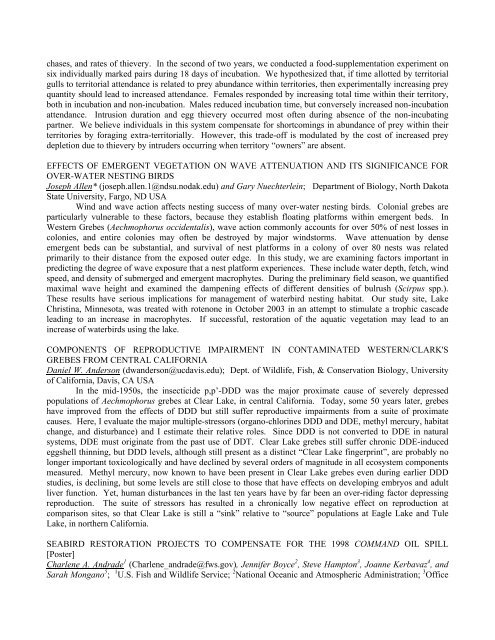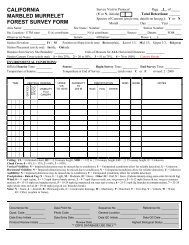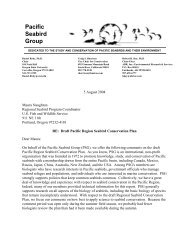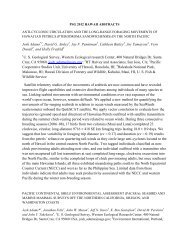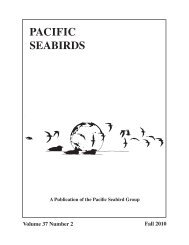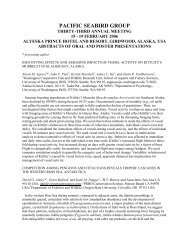abstracts of oral and poster presentations - Pacific Seabird Group
abstracts of oral and poster presentations - Pacific Seabird Group
abstracts of oral and poster presentations - Pacific Seabird Group
You also want an ePaper? Increase the reach of your titles
YUMPU automatically turns print PDFs into web optimized ePapers that Google loves.
chases, <strong>and</strong> rates <strong>of</strong> thievery. In the second <strong>of</strong> two years, we conducted a food-supplementation experiment on<br />
six individually marked pairs during 18 days <strong>of</strong> incubation. We hypothesized that, if time allotted by territorial<br />
gulls to territorial attendance is related to prey abundance within territories, then experimentally increasing prey<br />
quantity should lead to increased attendance. Females responded by increasing total time within their territory,<br />
both in incubation <strong>and</strong> non-incubation. Males reduced incubation time, but conversely increased non-incubation<br />
attendance. Intrusion duration <strong>and</strong> egg thievery occurred most <strong>of</strong>ten during absence <strong>of</strong> the non-incubating<br />
partner. We believe individuals in this system compensate for shortcomings in abundance <strong>of</strong> prey within their<br />
territories by foraging extra-territorially. However, this trade-<strong>of</strong>f is modulated by the cost <strong>of</strong> increased prey<br />
depletion due to thievery by intruders occurring when territory “owners” are absent.<br />
EFFECTS OF EMERGENT VEGETATION ON WAVE ATTENUATION AND ITS SIGNIFICANCE FOR<br />
OVER-WATER NESTING BIRDS<br />
Joseph Allen* (joseph.allen.1@ndsu.nodak.edu) <strong>and</strong> Gary Nuechterlein; Department <strong>of</strong> Biology, North Dakota<br />
State University, Fargo, ND USA<br />
Wind <strong>and</strong> wave action affects nesting success <strong>of</strong> many over-water nesting birds. Colonial grebes are<br />
particularly vulnerable to these factors, because they establish floating platforms within emergent beds. In<br />
Western Grebes (Aechmophorus occidentalis), wave action commonly accounts for over 50% <strong>of</strong> nest losses in<br />
colonies, <strong>and</strong> entire colonies may <strong>of</strong>ten be destroyed by major windstorms. Wave attenuation by dense<br />
emergent beds can be substantial, <strong>and</strong> survival <strong>of</strong> nest platforms in a colony <strong>of</strong> over 80 nests was related<br />
primarily to their distance from the exposed outer edge. In this study, we are examining factors important in<br />
predicting the degree <strong>of</strong> wave exposure that a nest platform experiences. These include water depth, fetch, wind<br />
speed, <strong>and</strong> density <strong>of</strong> submerged <strong>and</strong> emergent macrophytes. During the preliminary field season, we quantified<br />
maximal wave height <strong>and</strong> examined the dampening effects <strong>of</strong> different densities <strong>of</strong> bulrush (Scirpus spp.).<br />
These results have serious implications for management <strong>of</strong> waterbird nesting habitat. Our study site, Lake<br />
Christina, Minnesota, was treated with rotenone in October 2003 in an attempt to stimulate a trophic cascade<br />
leading to an increase in macrophytes. If successful, restoration <strong>of</strong> the aquatic vegetation may lead to an<br />
increase <strong>of</strong> waterbirds using the lake.<br />
COMPONENTS OF REPRODUCTIVE IMPAIRMENT IN CONTAMINATED WESTERN/CLARK'S<br />
GREBES FROM CENTRAL CALIFORNIA<br />
Daniel W. Anderson (dw<strong>and</strong>erson@ucdavis.edu); Dept. <strong>of</strong> Wildlife, Fish, & Conservation Biology, University<br />
<strong>of</strong> California, Davis, CA USA<br />
In the mid-1950s, the insecticide p,p’-DDD was the major proximate cause <strong>of</strong> severely depressed<br />
populations <strong>of</strong> Aechmophorus grebes at Clear Lake, in central California. Today, some 50 years later, grebes<br />
have improved from the effects <strong>of</strong> DDD but still suffer reproductive impairments from a suite <strong>of</strong> proximate<br />
causes. Here, I evaluate the major multiple-stressors (organo-chlorines DDD <strong>and</strong> DDE, methyl mercury, habitat<br />
change, <strong>and</strong> disturbance) <strong>and</strong> I estimate their relative roles. Since DDD is not converted to DDE in natural<br />
systems, DDE must originate from the past use <strong>of</strong> DDT. Clear Lake grebes still suffer chronic DDE-induced<br />
eggshell thinning, but DDD levels, although still present as a distinct “Clear Lake fingerprint”, are probably no<br />
longer important toxicologically <strong>and</strong> have declined by several orders <strong>of</strong> magnitude in all ecosystem components<br />
measured. Methyl mercury, now known to have been present in Clear Lake grebes even during earlier DDD<br />
studies, is declining, but some levels are still close to those that have effects on developing embryos <strong>and</strong> adult<br />
liver function. Yet, human disturbances in the last ten years have by far been an over-riding factor depressing<br />
reproduction. The suite <strong>of</strong> stressors has resulted in a chronically low negative effect on reproduction at<br />
comparison sites, so that Clear Lake is still a “sink” relative to “source” populations at Eagle Lake <strong>and</strong> Tule<br />
Lake, in northern California.<br />
SEABIRD RESTORATION PROJECTS TO COMPENSATE FOR THE 1998 COMMAND OIL SPILL<br />
[Poster]<br />
Charlene A. Andrade 1 (Charlene_<strong>and</strong>rade@fws.gov), Jennifer Boyce 2 , Steve Hampton 3 , Joanne Kerbavaz 4 , <strong>and</strong><br />
Sarah Mongano 5 ; 1 U.S. Fish <strong>and</strong> Wildlife Service; 2 National Oceanic <strong>and</strong> Atmospheric Administration; 3 Office


